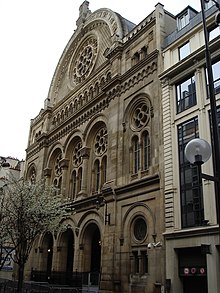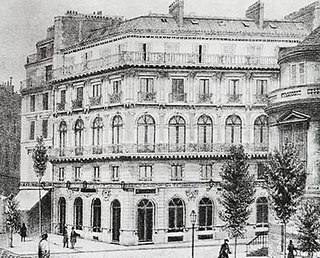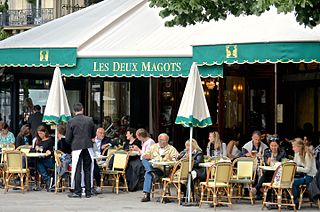
The 6th arrondissement of Paris is one of the 20 arrondissements of the capital city of France. In spoken French, it is referred to as le sixième.

Rue de Rivoli is a street in central Paris, France. It is a commercial street whose shops include leading fashionable brands. It bears the name of Napoleon's early victory against the Austrian army, at the Battle of Rivoli, fought on 14–15 January 1797. Developed by Napoleon through the heart of the city, it includes on one side the north wing of the Louvre Palace and the Tuileries Gardens.

The Place Vendôme, earlier known as Place Louis-le-Grand, and also as Place Internationale, is a square in the 1st arrondissement of Paris, France, located to the north of the Tuileries Gardens and east of the Église de la Madeleine. It is the starting point of the Rue de la Paix. Its regular architecture by Jules Hardouin-Mansart and pedimented screens canted across the corners give the rectangular Place Vendôme the aspect of an octagon. The original Vendôme Column at the centre of the square was erected by Napoleon I to commemorate the Battle of Austerlitz; it was torn down on 16 May 1871, by decree of the Paris Commune, but subsequently re-erected and remains a prominent feature on the square today.

The Musée Carnavalet in Paris is dedicated to the history of the city. The museum occupies two neighboring mansions: the Hôtel Carnavalet and the former Hôtel Le Peletier de Saint Fargeau. On the advice of Baron Haussmann, the civil servant who transformed Paris in the latter half of the 19th century, the Hôtel Carnavalet was purchased by the Municipal Council of Paris in 1866; it was opened to the public in 1880. By the latter part of the 20th century, the museum was full to capacity. The Hôtel Le Peletier de Saint Fargeau was annexed to the Carnavalet and opened to the public in 1989.

Louis Tullius Joachim Visconti was an Italian-born French architect and designer.
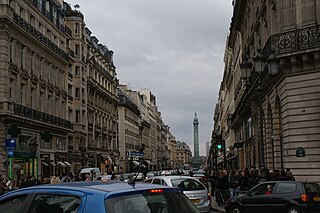
The rue de la Paix is a fashionable shopping street in the center of Paris. Located in the 2nd arrondissement of Paris, running north from Place Vendôme and ending at the Opéra Garnier, it is best known for its jewellers, such as the shop opened by Cartier in 1898. Charles Frederick Worth was the first to open a couture house in the rue de la Paix. Many buildings on the street are inspired in design by the hôtels particuliers of Place Vendôme.

Haussmann's renovation of Paris was a vast public works programme commissioned by Emperor Napoleon III and directed by his prefect of Seine, Georges-Eugène Haussmann, between 1853 and 1870. It included the demolition of medieval neighbourhoods that were deemed overcrowded and unhealthy by officials at the time; the building of wide avenues; new parks and squares; the annexation of the suburbs surrounding Paris; and the construction of new sewers, fountains and aqueducts. Haussmann's work was met with fierce opposition, and he was finally dismissed by Napoleon III in 1870; but work on his projects continued until 1927. The street plan and distinctive appearance of the centre of Paris today are largely the result of Haussmann's renovation.
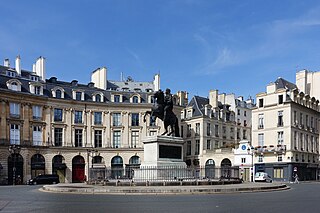
The Place des Victoires is a circular place in Paris, located a short distance northeast from the Palais Royal and straddling the border between the 1st and the 2nd arrondissements. The Place des Victoires is at the confluence of six streets: Rue de la Feuillade, Rue Vide Gousset, Rue d'Aboukir, Rue Étienne Marcel, Rue Croix-des-Petits-Champs, and Rue Catinat.

This "quartier" of Paris got its name from the rue de la Chaussée-d'Antin in the 9th arrondissement of Paris. It runs north-northwest from the Boulevard des Italiens to the Église de la Sainte-Trinité.

The Hôtel de Toulouse, former Hôtel de La Vrillière is located at 1 rue de La Vrillière, in the 1st arrondissement of Paris. It was built between 1635 and 1640 by François Mansart, for Louis Phélypeaux, seigneur de La Vrillière.
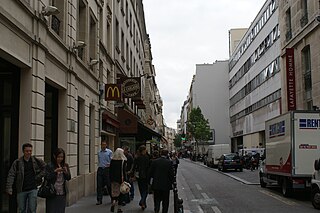
The rue de Provence is a street located in the 8th and 9th Arrondissements of Paris. It begins at the rue du Faubourg Montmartre and ends at the rue de Rome. Only the short part of the street between rue du Havre and rue de Rome is in the 8th arrondissement.

The rue Joubert is a street in the 9th arrondissement of Paris, France.
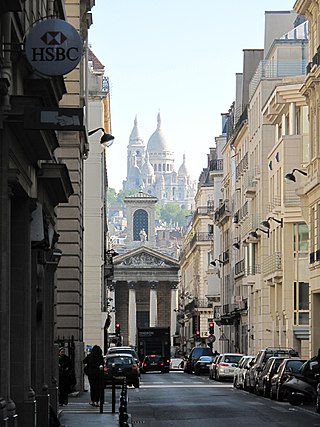
Rue Laffitte is a street in the 9th arrondissement of Paris, located near the Metro stations Richelieu - Drouot and Notre-Dame-de-Lorette.

The Rue du Bœuf is a 188-metre cobbled pedestrian street of the Vieux Lyon quarter, located in the 5th arrondissement of Lyon. Very representative of the Renaissance architecture of the neighborhood, it is lined only with old houses from the 16th or 17th century. The street connects the rue de Gadagne which it continues after the Place du Petit Collège and the intersection of the rue du Chemin Neuf, the rue de la Bombarde and the rue Tramassac which prolongs it. The street belongs to the zone classified as World Heritage Site by UNESCO.

Rue Bonaparte is a street in the 6th arrondissement of Paris. It spans the Quai Voltaire/Quai Malaquais to the Jardin du Luxembourg, crossing the Place Saint-Germain-des-Prés and the place Saint-Sulpice and has housed many of France's most famous names and institutions as well as other well-known figures from abroad. The street runs through the heart of the fashionable Left Bank and is characterised by a number of 'hôtels particuliers' and elegant apartment buildings as well as being bounded by the river at one end and the park at the other. With fifteen buildings or monuments classified as Monument Historique, it has more such listed sites than any other street in the 6th arrondissement.

The Rue Radziwill is a street in the 1st arrondissement of Paris. It starts at 1 rue des Petits-Champs and ends in a dead end. It was named after Polish Prince, politician and one of the wealthiest men in Europe Karol Stanisław Radziwiłł.

The Rue Saint-Lazare is a street in the 8th and 9th arrondissements of Paris, France. It starts at 9 Rue Bourdaloue and 1 Rue Notre-Dame-de-Lorette, and ends at Place Gabriel-Péri and Rue de Rome.
The authorities of medieval Paris attempted to confine prostitution to a particular district. Louis IX (1226–1270) designated nine streets in the Beaubourg Quartier where it would be permitted. In the early part of the 19th century, state-controlled legal brothels started to appear in several French cities. By law, they had to be run by a woman and their external appearance had to be discreet. The maisons were required to light a red lantern when they were open (from which is derived the term red-light district and the prostitutes were only permitted to leave the maisons on certain days and only if accompanied by its head. By 1810, Paris alone had 180 officially approved brothels.


